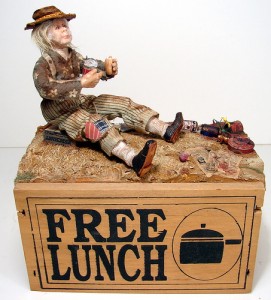There Used to Be Such a Thing as a Free Lunch
Tyler Cowen writes books more often than some people brush their teeth. He also blogs many times each day, including weekends, and does a variety of other productive, interesting things.
His latest book, An Economist Gets Lunch: New Rules for Everyday Foodies, is probably my favorite thing he’s written. (It’s not out ’til spring; I am lucky enough to have scored an advance copy.) It does such a good job exploring the economics, culture, esthetics, and realities of the food network that I don’t even mind the short shrift he gives Japanese cuisine (while being more thorough with Vietnamese, Korean, Indian, Thai, Filipino, and especially Chinese food).
 Photo: MiniatureMadness
Photo: MiniatureMadnessThere are a number of mind-blowing ideas and facts in the book, the most interesting of them in a chapter called “How American Food Got Bad.” We’ll get into those specifics at a later date on this blog and on our radio program. (I interviewed Tyler for an hour the other day for the radio show — excellent! On that same day, I also got to interview Alan Krueger and Danny Kahneman; I am a very lucky fellow.) For now, I just wanted to share one brief bit in a section about how Prohibition hurt our food development because alcohol sales subsidized food and food innovation:
Looking back in history, formerly you could take advantage of this cross-subsidy far more than is possible today. For instance nineteenth century saloons took the drinks cross-subsidy to an extreme by offering, literally, a free lunch to their customers. Once food supply became liberated from local farmers and hunters, such free lunches became common. The hope, of course, was that they would make the money back on the drinks.
An 1899 survey of 634 saloons in Minneapolis found that the free lunches were “elaborate” in 3 saloons, “excellent” in 8, “good” in 50, “fair” in 88, “poor” in 77, and the rest provided no free lunch whatsoever. A 1901 survey of 115 Chicago saloons found that “nearly all” offered free lunches; Chicago was especially known for the practice. At first it was a rigorous code of honor that the eater must also buy drinks.
But over time “free lunch freeloaders” became increasingly common, thereby rendering the deal increasingly unworkable from the restaurant’s point of view. By 1910 the free lunch practice was criticized for presenting unsanitary food (as more people take advantage of this kind of offer, the quality of the food has to be lowered if the saloon is to stay in business.) By the time war came to America in 1917, the practice was considered wasteful and was pretty much abandoned.
It is hard not to smile when one learns that Chicago was the epicenter of both the free lunch and the “no-such-thing-as-a-free-lunch” movements.

Comments